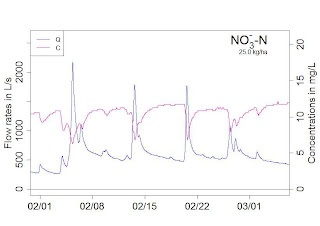The concept of hot spots and hot moments have gained popularity in the hydrology world and the near stream zone has been recognized for a long time as one of these hot spots. My mentor, adviser and now colleague Dr. Wayne Skaggs and I were talking about hysteresis in the water table versus drainage rate curves right after a rainfall events. Actually, most drainage models do not know how to handle this effect very well and that may be problematic. You will see in the video below that for a short period of time following a rainfall event (@ 110 hours in the simulation), drainage rates actually are, for the same water table height at mid field, a lot higher right after rainfall than they were prior to rainfall.
So what are the implications of this for water quality? Many things! To keep it short in this post, one thing is that the very high drainage rates imply intense leaching of the near stream (or in this simulation near ditch) zone. This likely explains to a significant part the 'dilution effect' of nitrate concentrations recorded in Brittany, France (see figure below). This dilution effect has historically been attributed to dilution by surface runoff. This may be true in many hillslope watersheds, but the hysteresis effect shown in the video can, by itself, explain this observation too! The reality is probably a combination of both in most watersheds.
